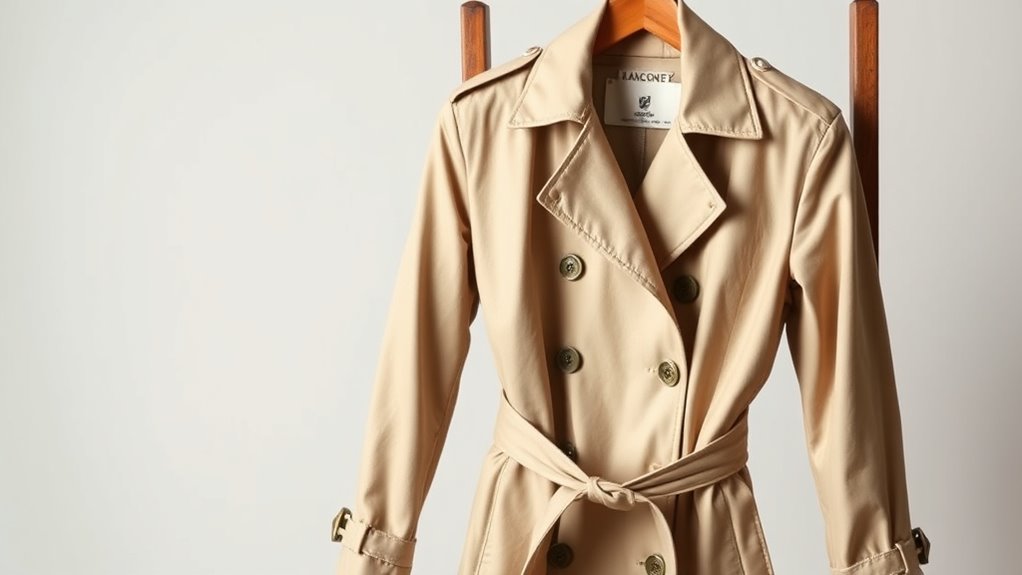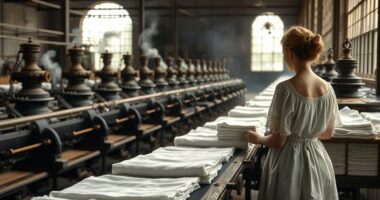The trench coat started as a military design during World War I, built for durability in muddy trenches, using waterproof fabrics like gabardine. Over time, it shifted from battlefield necessity to a fashion staple embraced by Hollywood stars and style icons for its rugged elegance and practicality. Modern versions incorporate innovative materials while maintaining its resilient roots. If you want to discover how this iconic piece continues to evolve, you’ll find plenty of fascinating details ahead.
Key Takeaways
- Originally designed during World War I for soldiers, emphasizing durability and weather resistance.
- Fabric innovations like gabardine made the coat lightweight, strong, and water-resistant, enhancing battlefield performance.
- Transitioned from military gear to fashionable outerwear, popularized by Hollywood icons and style influencers.
- Modern versions incorporate advanced textiles, waterproof leather, and sustainable materials, blending tradition with innovation.
- The trench coat remains a symbol of resilience and style, evolving from functional military attire to an enduring fashion statement.

Have you ever wondered how the classic trench coat became a timeless fashion staple? Its origins are deeply rooted in military history, where functionality and durability took precedence. During World War I, soldiers needed a reliable outer garment that could withstand harsh weather and provide practicality on the battlefield. This led to the development of the trench coat, designed with specific features like waterproof fabric, large pockets, and a double-breasted front. These elements weren’t just about style—they served real purposes. The coat’s name itself, “trench,” references the muddy, wet conditions soldiers faced in the trenches. As a result, the design became synonymous with resilience and utility.
Fabric innovation played a vital role in transforming the trench coat from a military necessity to a fashion icon. Early versions used oiled cotton or gabardine, a tightly woven fabric invented by Thomas Burberry in the early 1900s. Gabardine was lightweight yet strong, resistant to water, and breathable, making it ideal for soldiers enduring long campaigns in unpredictable weather. This innovation allowed the coat to perform under extreme conditions while remaining comfortable enough to wear over uniforms. After the war, civilians adopted the trench coat, appreciating its practicality and sleek appearance. Over time, designers experimented with new fabrics, blending traditional military materials with modern textiles, further enhancing the coat’s versatility and style.
The shift from military gear to everyday fashion was seamless. Hollywood stars and style icons recognized the coat’s chic silhouette and rugged charm, elevating it beyond its utilitarian roots. Today, fabric innovation continues to influence trench coat designs, with waterproof leather, technical synthetics, and sustainable materials being incorporated into contemporary versions. Despite these modern updates, the core elements that made the trench coat functional remain intact. It’s still crafted for durability, weather resistance, and timeless style. You can see this evolution reflected in the variety of cuts, colors, and fabrics available now, all paying homage to its military origins.
Ultimately, the trench coat endures because it combines purpose with style. Its journey from battlefield essential to fashion statement is a testament to how innovative fabric technology and a focus on function can shape iconic clothing. When you slip into a trench coat today, you’re wearing a piece of history—one that has been continually redefined through fabric innovation and military ingenuity, capturing both resilience and elegance in a single garment.
Frequently Asked Questions
What Materials Are Commonly Used in Modern Trench Coats?
Modern trench coats are made from a variety of fabric textures, such as cotton gabardine, polyester blends, and waterproof nylon, offering both durability and style. You’ll also find sustainable materials like organic cotton and recycled polyester, making them eco-friendly choices. These fabrics guarantee your trench coat remains functional and fashionable, whether you’re caught in rain or looking to make a sustainable fashion statement.
How Has Trench Coat Design Evolved Over the Decades?
You see that trench coat design has undergone significant fashion evolution over the decades. Initially built for functionality during wartime, it now reflects changing styles, with modern updates like slimmer fits, diverse fabrics, and fashion-forward details. The trench coat history shows how practicality blended with style, transforming from a utilitarian piece into a versatile fashion staple that adapts to trends while retaining its classic appeal.
Are Trench Coats Suitable for All Climates and Seasons?
You might think trench coats aren’t ideal for every climate, but their seasonal versatility is impressive. They’re perfect for rainy springs, cool autumn days, and even mild winter weather. While they may not suit extreme heat or deep cold, layering makes them adaptable. So, with the right climate suitability, you can enjoy a trench coat year-round, blending practicality with timeless style in various seasons.
What Are Some Iconic Trench Coat Brands and Designers?
You’ll love exploring iconic trench coat brands and designers known for luxury fashion and signature styles. Burberry is a top choice with its timeless, classic designs, while Aquascutum offers sophisticated, heritage pieces. Saint Laurent and Prada also deliver modern, high-end takes. These brands define the trench coat’s status as a versatile, stylish staple, blending function with high fashion, perfect for elevating any wardrobe with their distinct, signature styles.
How Should I Care for and Store My Trench Coat?
To keep your trench coat looking its best, follow proper cleaning tips like dry cleaning when needed and spot cleaning for minor stains. Store it on a sturdy hanger in a cool, dry place to maintain its shape, and avoid hanging it in direct sunlight. Use breathable garment bags for long-term storage, and make sure it’s completely dry before storing to prevent mold and odors.
Conclusion
Now, as you drape a trench coat over your shoulders, you carry more than just its fabric—you hold a story of war and fashion intertwined. It’s a reminder that something born for survival can become a symbol of style and sophistication. So, next time you wear it, think of the battlefield it once faced and the runway it now commands. In that contrast, you wear history, resilience, and timeless elegance all at once.










